Get Tech Tips
Subscribe to free tech tips.
Priorities of an Ideal HVAC System Design
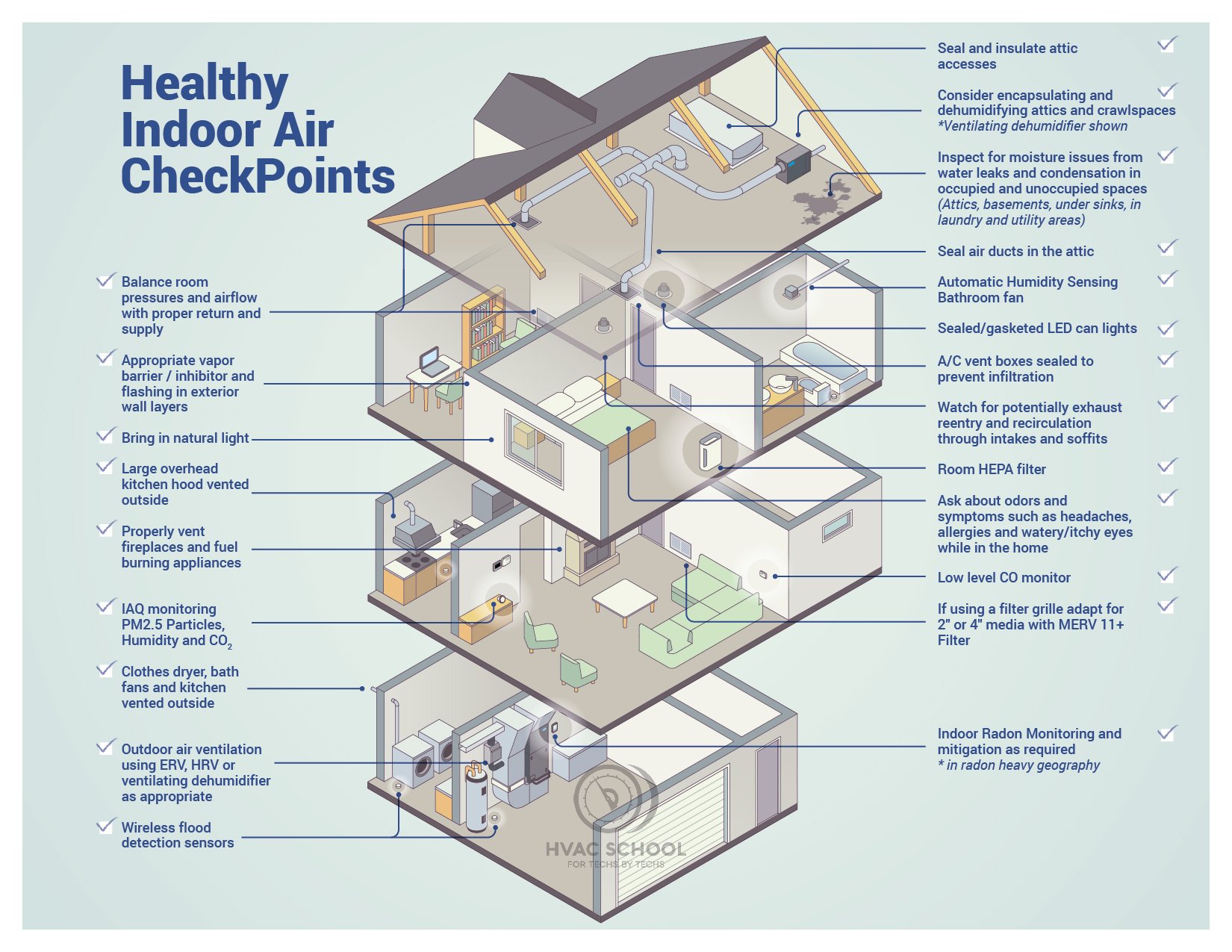
There is so much to consider on any sort of design project, and HVAC system design is no exception. Unfortunately, the priorities of engineers, builders, customers, and HVAC contractors don’t always align when it comes to designing and installing the “ideal” HVAC system.
On the one hand, the customers may prioritize aesthetics; they don’t want ANY visible ductwork in the living space (including registers and grilles). On the other hand, an HVAC system must be able to keep the building occupants comfortable and healthy. In other words, the “ideal” HVAC system design for an engineer is different from a contractor’s “ideal” HVAC system.
From the contractor’s perspective, I’d argue that the top priorities of an ideal HVAC system design are health, comfort, reliability, serviceability, and efficiency, in that order. This article will cover common obstacles to those priorities, how we can address those obstacles, and where the priorities might conflict with each other.
1. Health
Above all, an HVAC system needs to be able to keep building occupants healthy. The home is where a customer should feel safe; they shouldn’t feel sick as a result of poor air quality in their home.
At the same time, “health” is tricky because it's such a broad priority. There is so much that we need to consider when we think about keeping occupants safe and healthy in their homes.
Threats to a healthy home
Even though a lot of us like to believe that our homes should be safe, our homes actually contain many threats to our health. These threats may be as seemingly minor as allergens, and some of the more severe threats include carbon monoxide.
Particulate matter
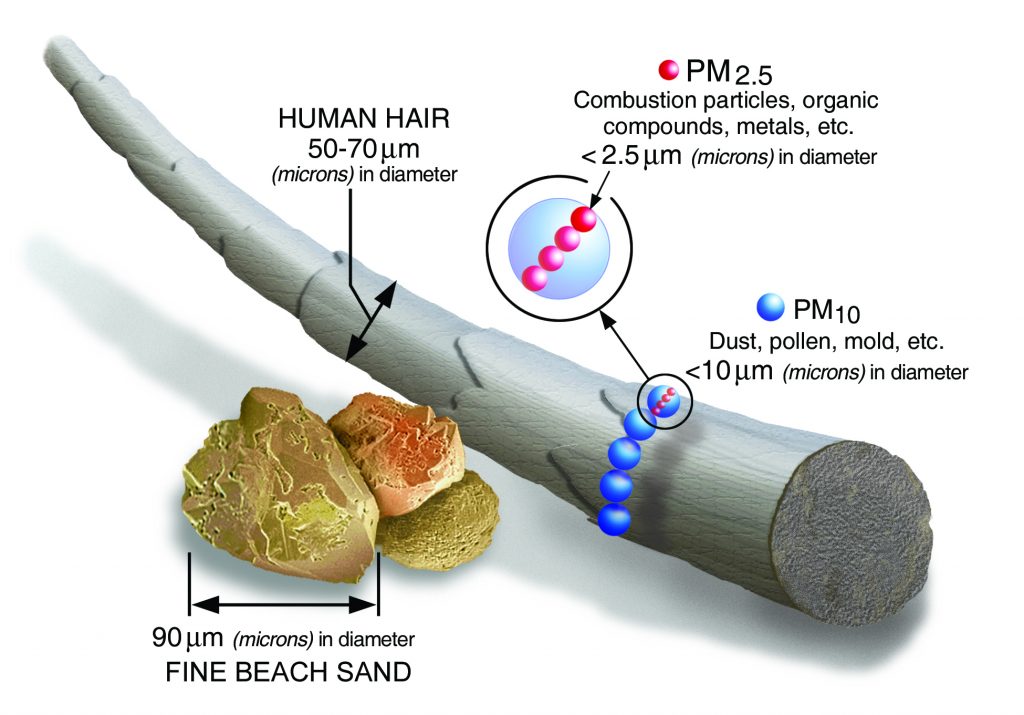
Small solid or biological materials are called particulate matter (or particulates). The worst are difficult to see with the naked eye, and they can cause severe problems for our respiratory systems.
The magic number is typically PM 2.5, which refers to particulates that are 2.5 microns in diameter or smaller. These particulates stay in the airstream longer than larger inhalable particles (up to PM 10) and some can directly enter the blood stream in the lungs. So, we especially want to try our best to limit the presence of particulates that are 2.5 microns wide and smaller.
Some of the most obvious threats, including pollen, dust, and pet dander, can cause allergies when unmitigated. Proper filtration is one of the most important ways we can combat the effects of allergens in our homes. (Not to mention, more frequent filter changes are required in cases where clients have shedding pets or plants indoors.)
Viruses, bacteria, and fungal spores are also well-known threats to indoor air quality. It’s easy for occupants to feel sick when viruses and bacteria can’t be caught or diluted. So, we need to think about multi-faceted approaches that address filtration and ventilation to tackle the challenges posed by viruses, bacteria, and fungal spores.
Harmful gases
Harmful gases can get into our homes from a variety of sources. These sources may include combustion equipment, the ground, furniture, or even our own noses and mouths!
Volatile organic compounds, also known as VOCs, are also threats present in almost every household. Furniture, paints, finishes, flooring, and household cleaners give off VOCs by off-gassing over time. When products off-gas, they release toxic chemicals from the base material; some of these toxic chemicals include formaldehyde. Formaldehyde is a known carcinogen, meaning that it has been known to cause cancer. It's also an ingredient found in cigarettes, used as a preservative for lab specimens, and used in some germicides.
Radon gas is a commonly overlooked threat; it’s a radioactive gas that comes from the soil and groundwater, and it can enter homes through plumbing and cracks. Radon also happens to be the number-one cause of lung cancer in non-smokers.
Carbon monoxide (CO) and carbon dioxide (CO2) are two other threats.
CO results from incomplete combustion in fueled appliances. These appliances include gas or oil furnaces, wood stoves, fireplaces, and gas water heaters. Our bodies can’t tolerate high amounts of CO because CO displaces oxygen in the bloodstream; CO makes it difficult for us to get the oxygen our organs need to function correctly. CO is especially dangerous because it’s colorless, odorless, and mixes well with air. You might not know that you’re experiencing carbon monoxide poisoning until you’re already sick.
CO2, on the other hand, is a normal product of respiration. However, it can also result in oxygen deprivation in high concentrations and may cause dizziness, headaches, and even nausea. Ventilation can help dilute the CO2 concentration and prevent symptoms of CO2 overexposure.
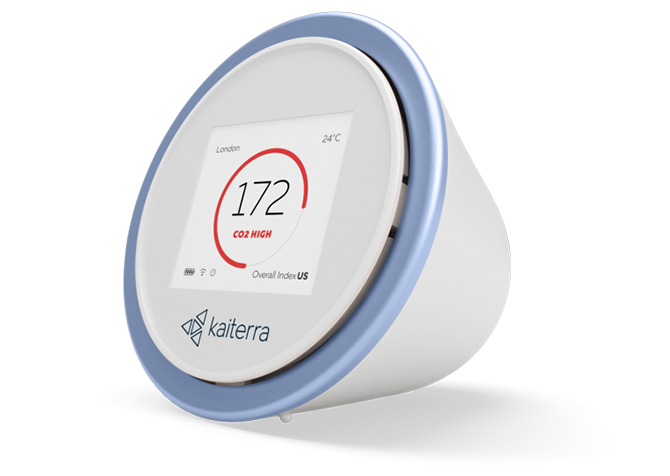
Filtration
We can make homes healthier by working to eliminate contaminants in the air, including allergens and volatile organic compounds (VOCs). One of the most basic but critical factors of indoor air quality is filtration.
When we think about system filtration, we have to make sure the air coming in through the return is cleaned before it passes through the blower and over the coil. Filter cabinets have to be able to house oversized media filters WITHOUT allowing for too much of a pressure drop across the filter. Pleated media filters with a greater surface area are better at catching pollen, dander, fungal spores, and even bacteria.
HEPA filtration received a lot of attention in the early phases of the COVID-19 pandemic as a promising way to hinder the airborne spread of SARS-CoV-2. HEPA filters are defined by their ability to reach a federal performance standard rather than design characteristics; these filters can theoretically remove 99.97% of particulate matter greater than or equal to 0.3 microns in size.
Particles smaller than 0.3 microns also move more erratically than those larger than 0.3 microns. That erratic motion allows them to be captured effectively by HEPA filters via diffusion. (Learn more about diffusion from Smart Air HERE.) Applying HEPA filtration to HVAC system design would be a huge step in the right direction regarding home health and safety.
One common form of HEPA filter installation is the bypass model, illustrated below:

The HEPA filter isn’t directly placed in the return; instead, there is a path of ductwork that allows some of the return air to divert from the main return duct and go through the HEPA filter box on the wall. Then, the air goes back into the return and has been filtered out by the time it reaches the fan coil.
HEPA filtration can be used with other IAQ products in a single unit, too.
UV lights and photocatalytic oxidation (PCO)
It’s time to talk about a couple of controversial technologies for home health and safety: UV lights and PCO products!
I generally feel that there is an appropriate time and place for both of these. However, they have to be used correctly, and each one has a set of risks. Those risks particularly have to do with ozone and other airborne oxidizers.
For the record, properly designed and installed UV lights ARE effective at destroying microbes on surfaces. When placed in close proximity to the evaporator coil, UV lights destroy bacteria and fungi that grow on the coil and can stop their spread.
However, residential UV lights are typically ineffective against airborne microbes; those microbes generally aren’t near the light long enough to be deactivated. UV lights also give off ozone, which is undesirable for indoor air quality.
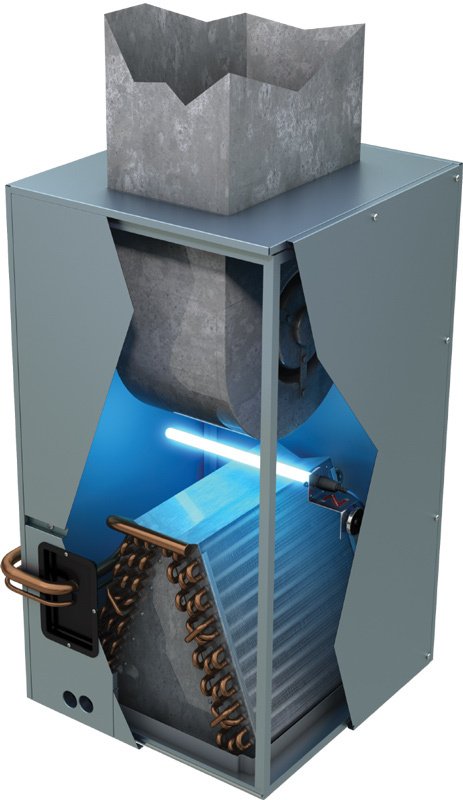
Also, if you stick the UV light inside the air handler, it will only be effective on the surfaces it shines on. If the UV light only shines on half of an A-coil, then the other half won’t receive the beneficial aspects of UV light.
PCO products use UV lighting to generate oxidizing ions to deactivate airborne contaminants. The sun does the same thing by causing reactions in the air and on surfaces.
Instead of using just a standard UV lamp to shine a light on surfaces, PCO products purify air within the airstream. When ozone from the UV lamp comes into contact with the photocatalytic filter inside the PCO product, hydroxyl ions develop. Ions have a charge and are unstable, so they want to bind to other particles. In the case of PCO products, these ions can bind to carbon-based contaminants and can neutralize them.
The downside is these reactions can create other unintended consequences and even more toxic byproducts. In the the cases of PCO, UV, Cold Plasma, Bi-polar and many other bolt on technologies the key is proper installation, no overselling the benefits and being aware of the risks.
Some products like the APCO-X shown below use carbon to help localize reactions and reduce the potential negative effects.
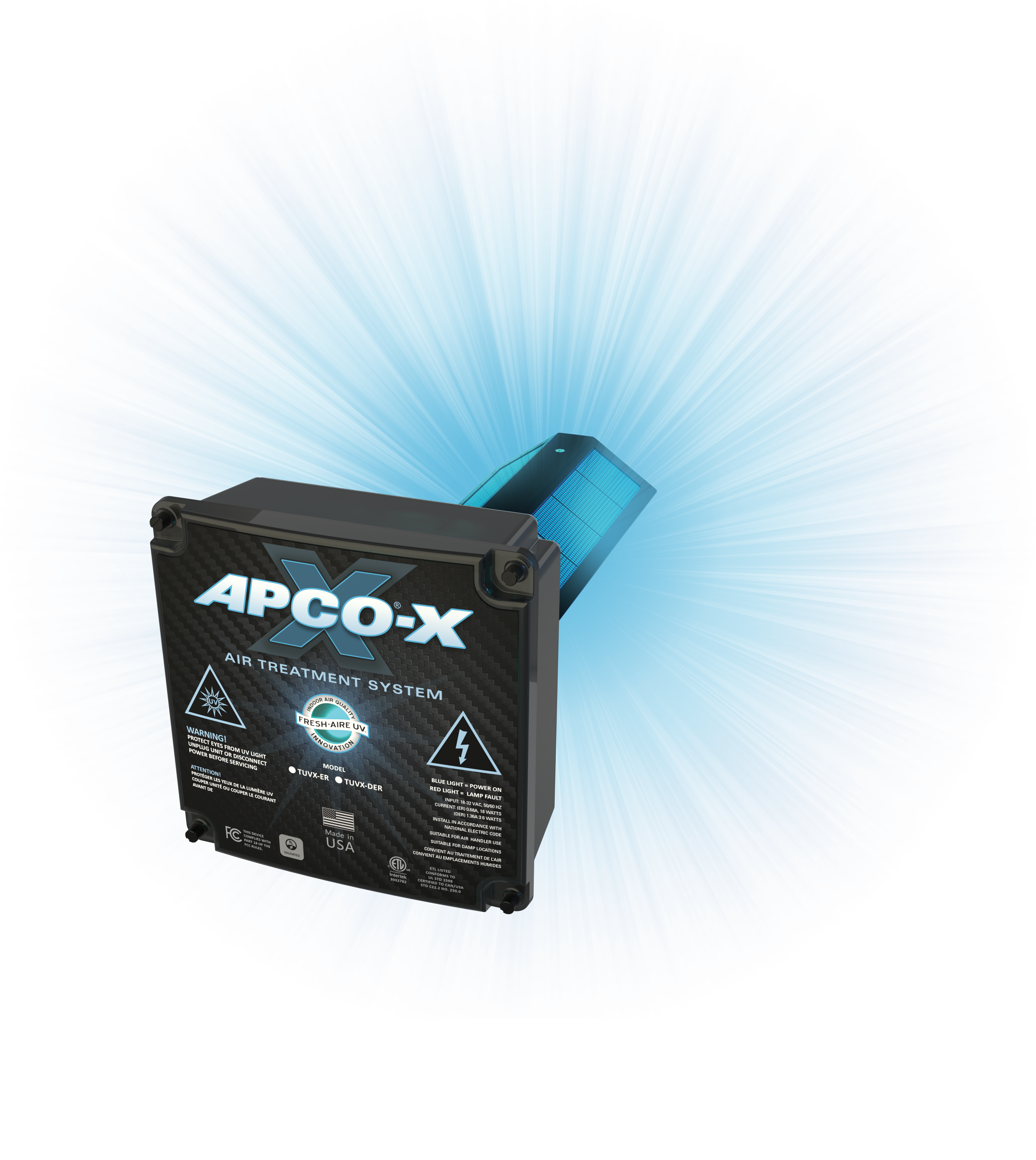
Ventilation
Diluting the presence of those “threats” is another way we can reduce health risks in homes. We can bring in outdoor air to help dilute concentrations of bacteria, viruses, CO2, radon, and VOCs in customers’ homes; doing so would reduce their likelihood of getting sick.
However, a high-quality ventilation system doesn’t just dump outdoor air into the return or pull air in from cracks when the occupant uses the bath fan. Good ventilation requires us to evaluate the quality of the air we’re bringing in and take steps to make it suitable for the home.
Ventilation has become more important since construction standards shifted to make houses tighter. Looser houses allowed more fresh air to come in naturally, but most new constructions (and those under 20 years old) need a bit of help in the ventilation department. Whether we use heat recovery ventilators (HRVs), energy recovery ventilators (ERVs), or a ventilation dehumidifier, we can give ourselves more control over the air we’re bringing into customers’ homes.
IAQ monitoring
So, we’ve established that we have a bunch of threats that are constantly trying to make us sick in our homes, but there are some ways to stop them. Fantastic.
That just leaves us with the following question: how are we supposed to control those gases and contaminants if we don’t know exactly what we’re dealing with at any given moment?
We already have carbon monoxide detectors that go off when dangerous levels of CO are present in the home. However, low-level CO monitors can alert occupants about even small amounts of CO in the home. Low-level CO monitors tend to be more expensive than basic detectors. However, they are a must-have for homeowners with gas appliances in their homes; they can prevent symptoms of illness from relatively low levels of CO, not just death from high levels.
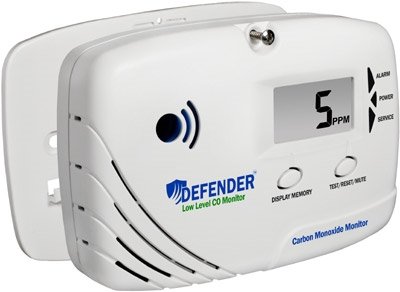
We have some other devices that monitor indoor air and can tell us when we’re dealing with potentially dangerous conditions beyond CO. One good example is the HAVEN central air monitor and controller.
Instead of doing occasional spot checks in one location, the central air monitor can detect poor air quality throughout the home. Then, the central air controller can take that data and activate equipment to resolve the issue. We could potentially use those technologies for demand ventilation purposes.
Controlling moisture with drainage safeties
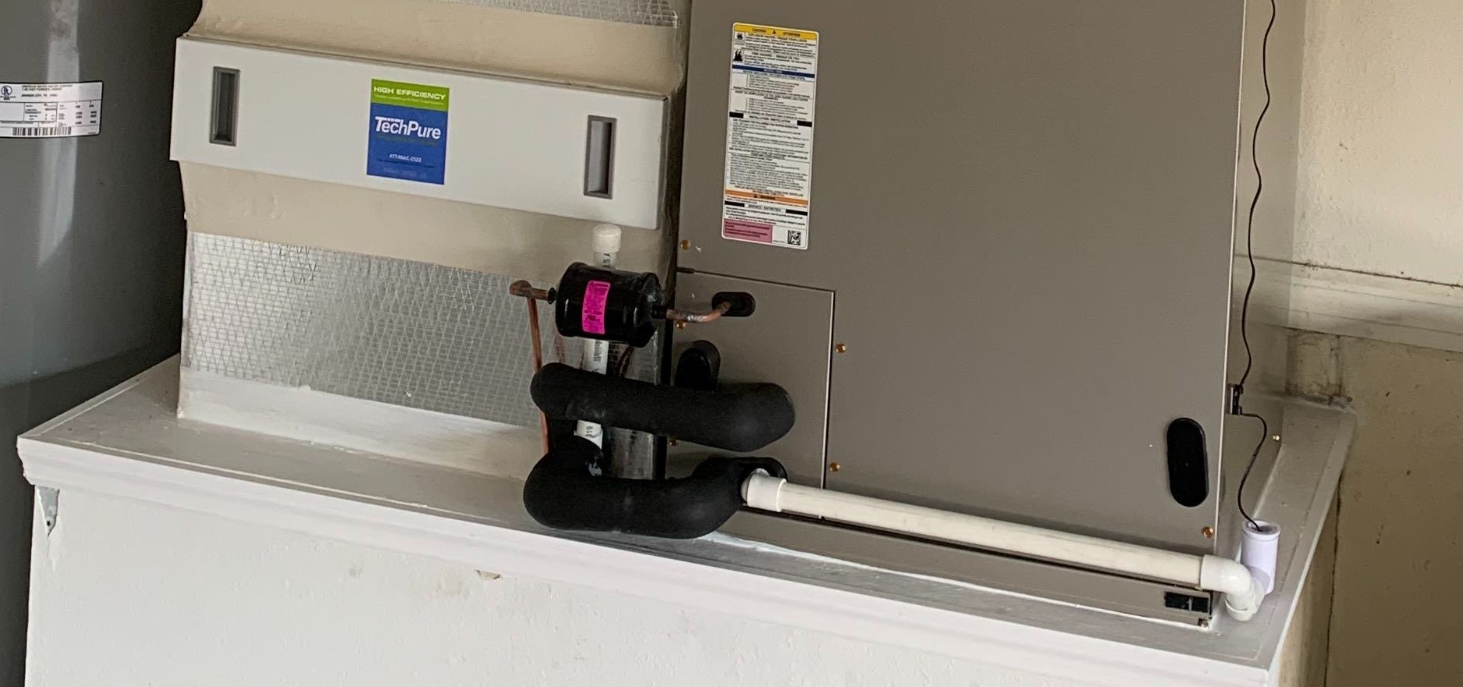
An overflowing drain pan or clogged drain can wreak havoc on a home. When water spills all over the place, that can bring up the humidity and set the stage for fungal growth.
To stop drains from overflowing, we need to focus on redundancy, redundancy, and redundancy. Sometimes, just one drain pan isn’t enough; a secondary drain pan can be a good lifeline. One float switch? How about two instead?
You might also consider getting a moisture alarm. Trust me; installing a moisture alarm isn’t overkill. Would you rather have a customer chew you out because there’s a flourish of mold all over the wall near the unit? I didn’t think so.
Humidification and dehumidification
A client’s need for humidification or dehumidification will depend a lot on their climate. While it would seem absolutely bonkers to put a humidifier in a Central Florida home, that would necessary for many homes in the dry mountains of Colorado.
Humidity is a major player in home health and safety. High humidity levels may allow fungi, mites, and VOCs to run rampant in a home. On the other side of the spectrum, homes that are too dry create great conditions for ozone production and respiratory infections to occur. Extremes on either side are beneficial for bacteria and viruses (not us) and may aggravate allergies or asthma.

In drier climates, a central humidifier can add moisture to the airstream. Homes in hot, dry places like Australia and the Southwestern USA may also benefit from using an evaporative (swamp) cooler. But what about dehumidification?
Dehumidification with the HVAC unit alone
The HVAC system can dehumidify air on its own to some extent. Whenever air passes over a cold evaporator coil, the reduction in temperature reduces the amount of moisture the air is able to hold. Since the air is unable to hold all of the moisture, some of that water vapor has to come out of the air by condensing on the coil.
But hold up! If that’s the case, then why is the supply relative humidity so high? The relative humidity is high because the temperature has gone down. However, the absolute moisture is much lower; some water has already come out of the air by condensing on the coil.
To get that dehumidification out of your HVAC system in cooling mode, you need to be able to run the equipment for a long time and have a low evaporator temperature. If you run your evaporator too cold, however, freezing and objectionable condensation is possible. You also need to have a sufficient sensible load before you can get that latent removal.
So, you’ll probably have to set your thermostat a little too cold for some people’s comfort. That can be especially challenging if you and your spouse or kids can’t agree on a comfortable temperature.
That brings me to my next priority…
2. Comfort
This second priority should come as no surprise. Remember, we are in the business of making people comfortable in their homes.
Like health, “comfort” is broad and multifaceted. We’re not just thinking about temperature; we’re also thinking about humidity, radiant gains, circulation, noises, and odors as well.
Humidity
Humidity is what bridges the gap between health and comfort. The recommended relative humidity range for optimal occupant health is also generally pretty comfortable for most humans. Depending on who you ask, the “safe” range is typically anywhere between 30 and 60% RH, with 50-55% being a common target.
Comfort gets tricky when you have to balance latent and sensible loads. As I said before, you need to have a sufficient sensible load to get the most out of your HVAC system’s latent removal capabilities. Many people simply can’t tolerate colder temperatures the way others do, so the added comfort from dehumidification still doesn’t make the home completely comfortable. (Check out THIS short interview with Matt Risinger for an idea of what I’m talking about.)
That’s where dehumidifiers can come in handy. Like heat pumps and A/C units, many dehumidifiers have a coil that pulls moisture out of the air by making it condense. However, the air that leaves a dehumidifier is typically warmer than what you’d expect out of a straight-cool system or a heat pump in cooling mode.

Some dehumidifiers, including some of the ones in the Santa Fe Ultra Series, also allow you to bring in ventilation air. These systems have two return openings; one is for air inside the home (typically the larger one on the bottom), and the other is for outdoor air to come on. In many cases, the amount of incoming outdoor air is controlled by a damper (often a motorized damper with an ECM).
Of course, health remains the number-one priority, but comfort is a close second. In humid climates, dehumidifiers can help building occupants have both at once.
Temperature
Temperature is probably what most people think about with regard to comfort. (Think: If you’re in a car with somebody and they ask if you’re comfortable, many of us would probably assume that the driver is asking about the temperature.)
As mentioned before, the temperature is a common point of contention in houses with multiple occupants; couples and families can’t always agree on what’s comfortable for everyone. Accessories (like dehumidifiers) and controlling radiant gains can help with that.
However, in the heating season, we need to think about how well the HVAC system can keep a system warm. For a while, heat pumps had a bad reputation in colder climates because they couldn’t bring enough heat indoors; it was simply too cold outside.
Nowadays, heat pumps are becoming commonplace even in bitter-cold places like Norway. Bill Spohn used a heat pump for his Net Zero SpohnHome in Pennsylvania. He recently told us that his heat pump managed to stay within two degrees of the setpoint in subzero temperatures WITHOUT the backup heat!
Mean radiant effect
HVAC equipment can control the temperature and humidity of the air, but it doesn’t really do anything about radiant heat.
Radiant heat is transmitted via electromagnetic waves; crowded rooms tend to be warmer than empty rooms because our bodies emit radiant heat. The sun is also a significant source of radiant heat; the sun’s radiation can come in through windows or by being absorbed by roofs and walls. Not to mention, all of the objects around us radiate heat.
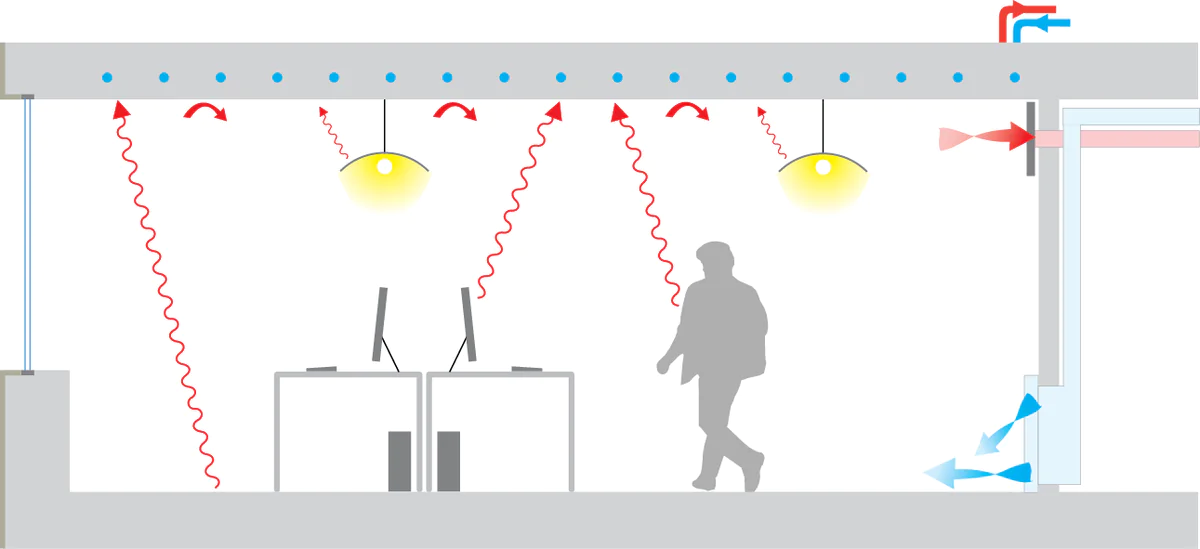
In a sense, we have to control the temperatures of all the surfaces in a building by paying attention to the materials used in its construction. For example, roof tiles and walls (especially dark ones) absorb a lot of heat, and that heat can be given off inside the home.
Controlling radiant gains
Passive houses focus on using windows to manipulate the heat content indoors, so passive house designers look for glass windows with low U-values. The U-value refers to the transmission of radiant heat out of a specific type of building material. (Compare that to the R-value, which measures the resistance of heat transfer. Passive house designers tend to use materials with higher R-values.)
Some people may have radiant barriers installed in the attic, which are giant sheets of foil draped over the trusses or built into the plywood. The foil is highly reflective, meaning that it reflects radiative heat back to the roof and keeps the attic cool. (Radiant barriers can cause your ducts to sweat A LOT, but that’s beyond the scope of this article.)
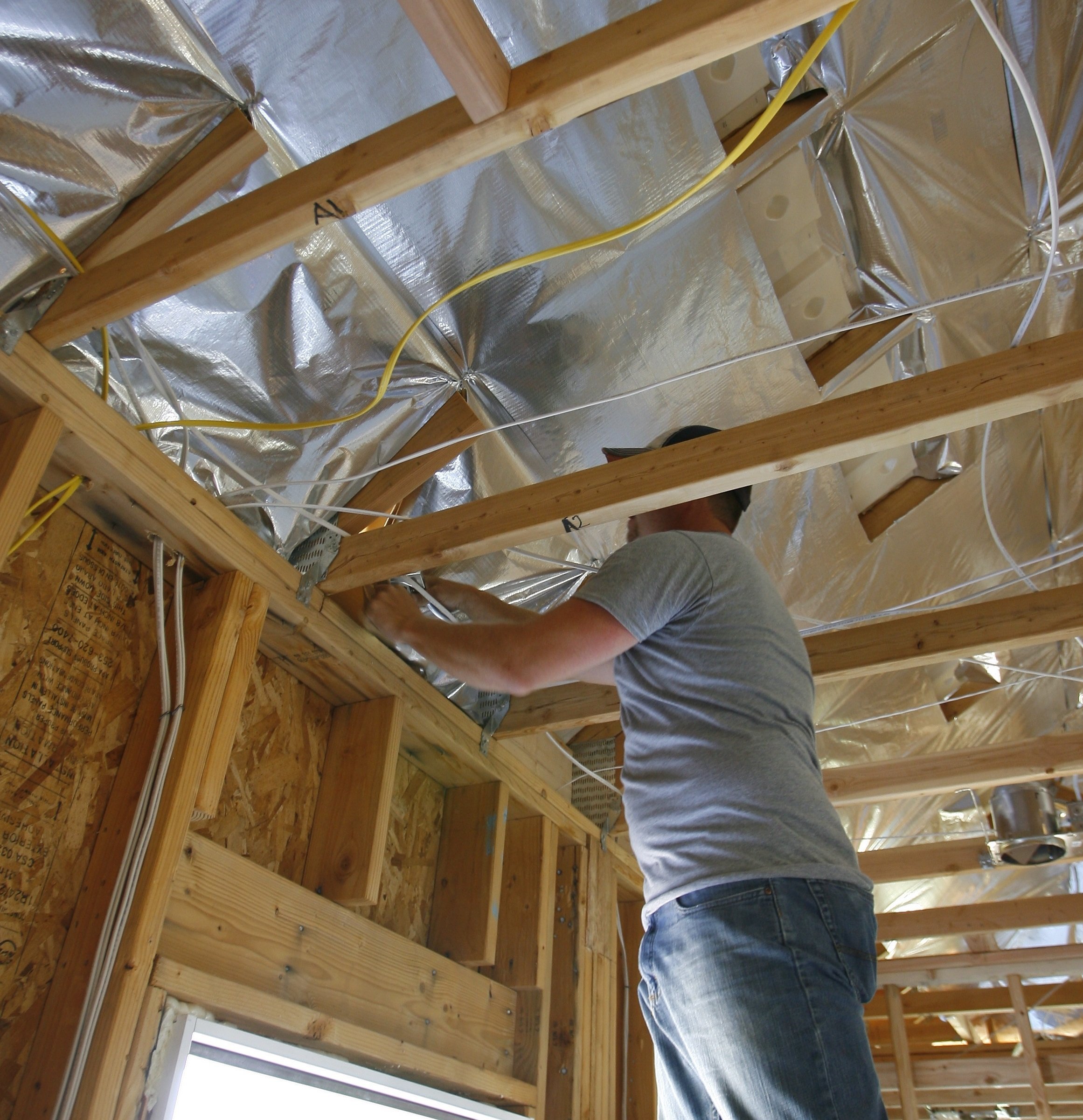
Radiant barriers, insulation, window placement (and opacity), and occupant behavior all have to be considered when designing an HVAC system AND the building as a whole. That's pretty important because, in the words of Kaleb Saleeby, a building is a system of systems.
Speaking of Kaleb, he wrote a neat article on mean radiant temperature (MRT) that can help you understand how radiant gains affect indoor comfort. You can read that article HERE.
Noise
Since there’s so much focus on temperature and humidity, it’s easy to forget about noise and its impact on client comfort.
In many cases, the “ideal” HVAC system would be one that the occupant can’t hear. So, to achieve that goal, we really have to turn our attention to the ductwork. Noise often comes from the equipment itself (such as the blower fan) or turbulence in the duct from high air velocity. Some noise is also generated around vents and registers.
Equipment noise can be reduced with proper installation. We can avoid noise issues from turbulence and high air velocity by designing systems with larger registers and balancing dampers.
Exposed ductwork requires special attention, as the noise from the fan or turbulence within the duct is much closer to the living space. Nowadays, we have more sound-attenuating accessories than ever before to help with noise from exposed ducts.
We can also decouple the ductwork from the structure to reduce vibration and noise. Canvas connectors and vibration pads can help a lot.
Odors
Many of us probably don’t think of odors as a comfort factor. However, odors have a pretty big impact on how we feel in a given space. I definitely feel more comfortable in a bakery than in a sweaty locker room at the gym regardless of the temperature and humidity.
Of course, that’s an extreme comparison, but the point stands that odor is a comfort factor. The HVAC system shouldn’t give off significant odors (barring malfunction situations like compressor burnouts, gas leaks, or overheated motors). It’s normal for an evaporator coil to get dirty over time, which may result in a musty odor.
Regular maintenance is perhaps the best way to stop odors, but that isn’t part of the design process. We could consider installing UV lights near evaporator coils to prevent microbial growth. However, as I said before, that isn’t a fix-all solution and can be misused.
It’s also worth noting that nice aromas aren’t necessarily good. “New-car smell” is a perfect example; you can find “new-car smell” air fresheners and candles because many people like the scent, but “new-car smell” actually comes from off-gassing (VOCs)! The chemicals used in the car interior, including the plastics and fabrics, give off VOCs. So, those harmful VOCs are the source of the pleasant smell we associate with new cars. In those types of cases, customer health must come before “comfort” associated with VOC smells.
3. Reliability
When we sell new HVAC equipment to a customer, we expect it to reach its average lifespan. If the equipment fails before the 10 or 15-year warranty period is up, then that looks bad for everyone.
Even if a homeowner opts to install a system from a manufacturer that is notorious for premature component failures, the HVAC installer is the one who put it in. So, customers tend to assume (either rightfully or wrongfully so) that the installer is mostly responsible for how well equipment runs and how long it lasts.
Also, customers don’t want to spend several thousand dollars on a new HVAC system for at LEAST another 10-15 years.
The “reliability” piece of the ideal HVAC equipment puzzle can be a frustrating one for contractors. Are the equipment performance and longevity (as well as our reputations) NOT at the mercy of the manufacturer? That may seem to be the case, but our installation practices also have some bearing on the equipment’s longevity.
As contractors, it’s our responsibility to make sure we set the equipment up for success. For example, to make the condenser reject heat effectively and prevent the components inside the outdoor unit from overheating, we need to install the outdoor unit at least two feet away from walls, shrubbery, and other obstructions.
Drain design and installation
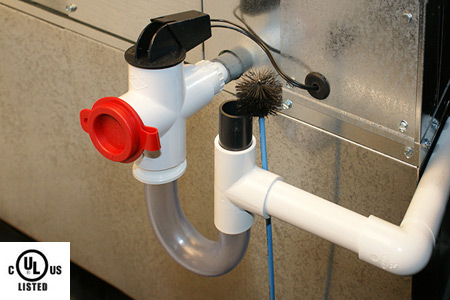
Drain assemblies can cause a lot of problems if they’re fabricated and installed incorrectly. When an HVAC installer sets up the drain assembly, they need to get the diameter and pitch right.
Local codes are the authority you should adhere to, but the International Mechanical Code (IMC) is a good general reference for best practices.
For example, the IMC states that the drain diameter should be AT LEAST ¾”. If the drain diameter is smaller than that, it would take a lot less to clog the drain line. At the very least, the float switch could trip prematurely and warrant a service call.
Drain pitch is another important area that installers need to pay attention to. The pitch is what allows gravity to take care of the drainage, and the IMC states that it should be 1% or ⅛” of fall for every foot of horizontal run. Personally, I try to make sure the Kalos installers set up drains with at least ¼” of fall for every foot of horizontal run.
As contractors, we also have to think about the placement of cleanouts, traps, and vents to keep drains from backing up and damaging the equipment (and customer property). In many cases, the manufacturer’s specs can give you an idea of how to set up the drain, but there may be some special considerations (such as with ductless systems that may need a check valve).
Why reliability is important for contractors too
The customer isn’t the only one who is affected by premature equipment failures. Those situations also pose challenges for us, the contractors, and it’s not just because we’re the ones who have to read one-star reviews and get nasty phone calls from angry customers.
You don’t need me to tell you this, but we have a labor shortage in the skilled trades. As a result, each preventable or warranty-related service call has a high opportunity cost. When technicians have to rack up overtime to keep up with premature failures, that can cause them to burn out and can be a huge expense for the contractor. In most cases, overtime pay is given at 1.5x an employee’s hourly rate and must be applied to all hours worked over 40 per week.
So, working 60-70 hours per week keeps technicians away from their families AND is a pretty big financial strain on the contractor. We typically don’t make money on callbacks or service calls for warranty-related failures, either.
All of this is just to say that reliability is clearly a priority for the customer, but it’s also one for the contractor. To get the most reliability out of HVAC systems, we need to hold ourselves and manufacturers accountable for premature failures within the warranty period.
4. Serviceability
One of the worst things about residential HVAC, especially when you’re working in fancier houses, is the lack of accessibility to equipment.
Whether you’ve got attic entrances in closets, outdoor units in a different ZIP code, or mildewy vents immediately above beds, you can tell that HVAC serviceability is an afterthought for many building designers. The worst thing of all is when people stuff units behind woodwork paneling with absolutely NO way to access it!
Aesthetics and serviceability are often at odds with each other, and many customers and engineers aren’t aware of the importance of serviceability. On the other hand, many of us technicians and contractors don’t care about carpet colors, ceiling textures, or how “fancy” a home looks; we just want to be able to do our jobs. It’s extremely frustrating for everyone involved when we can’t access equipment behind wood paneling.
News flash: that beautiful crown molding on each side of the wood paneling isn’t going to matter when the condensate pump backs up, overflows, and damages the walls because nobody was able to service it. You’d really put the “mold” in “crown molding.”
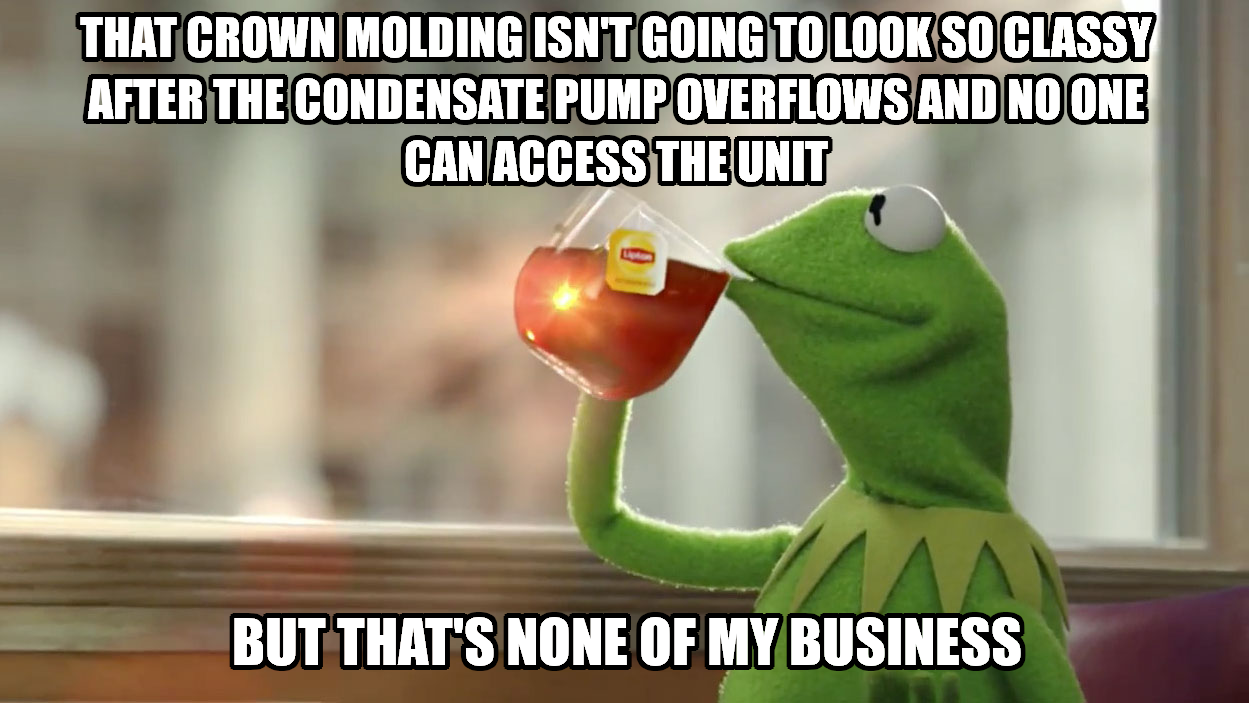
Component removal
Sometimes, we have to pull parts from the unit. Whether we need to clean or replace a part, it would help us a lot if we had easy access to the part in question. If we need to pull a blower wheel for cleaning, then it probably wouldn’t make sense for the air handler to be partially blocked by a pipe or conduit.
If we need to pull a compressor, it would be a lot easier if we could reach into the outdoor unit and grab it without having to worry about being pricked by a rosebush around the unit or stung by wasps in the shrubbery around the unit. (And as I mentioned before, shrubbery around the unit isn’t good for optimal performance and reliability anyway.)
Equipment location relative to faucets and electrical outlets
Our lives would be so much easier if we had a hose very close to the outdoor unit and if we had outlets and breakers right by the air handler. We could shut the power off, fix the unit, attach a foam gun to a hose, and just do our HVAC things in peace.
Unfortunately, that’s often just a fairytale dream. Placing equipment near faucets and outlets makes diagnosis, maintenance, and repairs a lot easier for us, as we aren’t wasting time running all around the property to find a hose, a breaker, or the thermostat.
When designers draw plans that keep the equipment far away from the water and power sources of a home, nobody should have the right to complain about us taking too long on our jobs. Even Bert’s favorite tip, “walk fast,” can only do so much to help us when we have to make 5003 trips between the unit and the power source on the other side of the building.
5. Efficiency
Efficiency is one of the most common selling points of HVAC equipment. Think about how many times you’ve gone to a manufacturer’s website and seen: “New high-efficiency ductless!” or “High-efficiency 26+ SEER!” After all, it sounds great to consume as little energy (in watts) in exchange for as many BTUs per hour as possible.
Efficiency is more than just a selling point, though. Manufacturers design equipment that complies with efficiency standards (like SEER). We’ve seen minimum SEER ratings increase from 10 SEER in 1992 to roughly 14 SEER nowadays (depending on location).
As manufacturers try to reach these efficiency targets, they develop systems that focus on moving sensible BTUs, NOT on latent capacity. As a result, you get a bunch of high-SEER variable-capacity (VC) units that can get long runtimes with low-stage cooling. When you run low-stage cooling, you get relatively warm evaporator coils, which are inadequate for dehumidification. You need a cold coil to pull water vapor out of the air via condensation.
Chuck Withers from the Florida Solar Energy Center wrote an interesting article about system efficiency, fixed vs. variable capacity systems, ducted vs. ductless systems, and dehumidification in Florida. If you’re interested in checking it out, you can find it HERE. In a nutshell, his work showed that ductless mini-splits tend to be more efficient than ducted systems (even with a lower SEER), VC units can generate longer runtimes and more efficient cooling than FC units, and that VC units with lower SEER ratings tended to outperform ones with higher SEER ratings in the dehumidification department.
High-performance low cooling load homes

High-performance homes, Net Zero homes, and passive houses focus on being as energy-efficient as possible, and many of them have low cooling loads as a result. Making these homes healthy and comfortable is quite challenging because efficiency is so often at odds with health and comfort.
The distribution of sensible heat is usually quite good in these homes, and that’s a strength of VC heat pumps with minimalistic ductwork. However, many of these homes struggle to stay under 60% RH in humid climates because the building and HVAC systems prioritize efficiency and sensible BTU removal instead of comfort and latent heat removal.
Then, of course, the main issue with supplemental dehumidification is its energy usage. Quite the conundrum, isn’t it?
The point is that comfort comes at a cost. Some high-performance homes have features that may help reduce the indoor moisture load, such as low-flow water fixtures, but that doesn’t magically stop water vapor from being present in a home; it just has the potential to reduce the moisture load. (Even so, occupant behavior is part of that equation, too. If the occupant decides to shower all day, then the low-flow water fixture won’t really mean much in the end.) There isn’t a perfect comfort solution that DOESN’T sacrifice efficiency to some extent.
So, how do we get an ideal HVAC system?
We can’t weigh all of these priorities equally and expect to get an HVAC system that can give us everything we want. We don’t currently have the tools in our toolboxes to do that.
It would be awesome if we could get 32-SEER heat pumps that dehumidify the air exactly how we want, are in easy-to-access locations, and that last well beyond the warranty period. Sadly, we have to make sacrifices somewhere.
We may have to use a bit more electricity by putting in a dehumidifier, using IAQ products, or running an IAQ monitor and controller. But those things will keep us healthier and safer. Maybe we’ll need to put the condenser in a location that isn't exactly photogenic; however, it might be worth it if it’ll keep us from dealing with the performance and reliability issues that could arise from long refrigerant lines.
Overall, a system that prioritizes health, comfort, and reliability above all might look like this:

In the end, we need to figure out what’s truly most important to the customer. Then, it's up to us to explain the pros and cons of the HVAC designs they want to include. We have to be able to see the bigger picture of the design and make sure our voices are heard. Most of all, it is our responsibility to make sure we install and service each HVAC system as best as we can.
We can also collaborate with engineers and other trades earlier in the design process. Whether our expertise will be taken seriously or not is out of our hands. However, we can at least make sure we share our educated opinions.











Comments
To leave a comment, you need to log in.
Log In